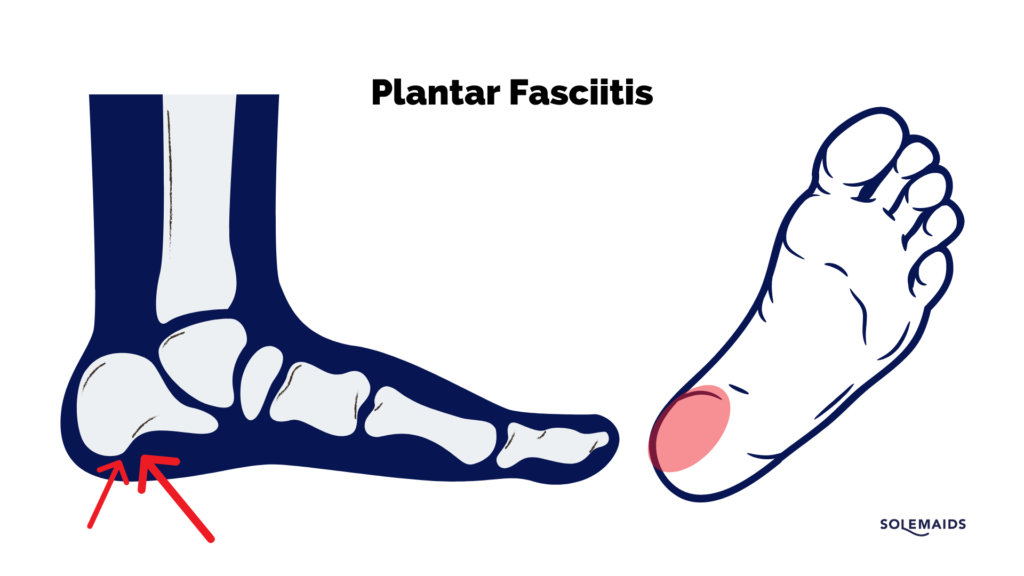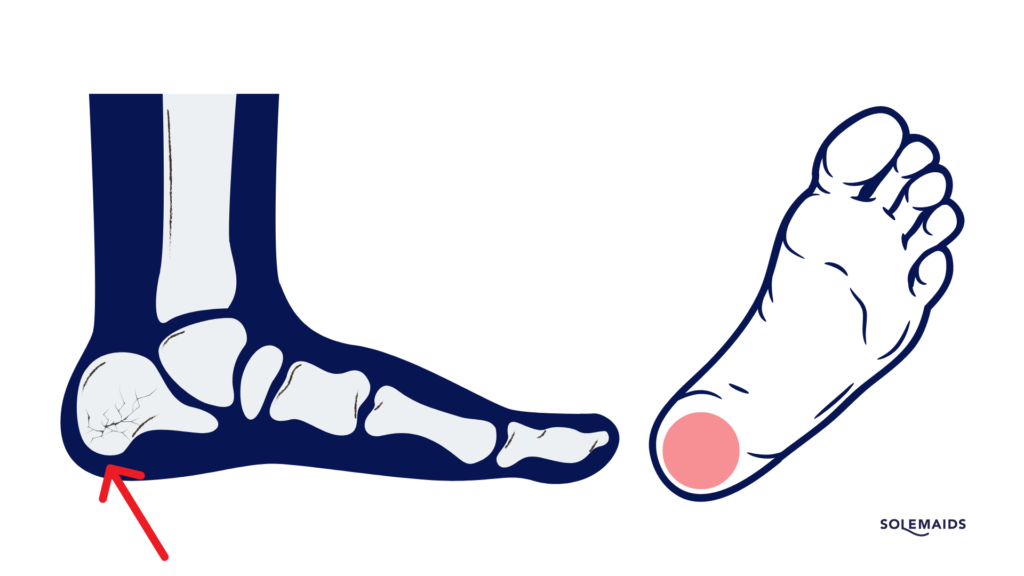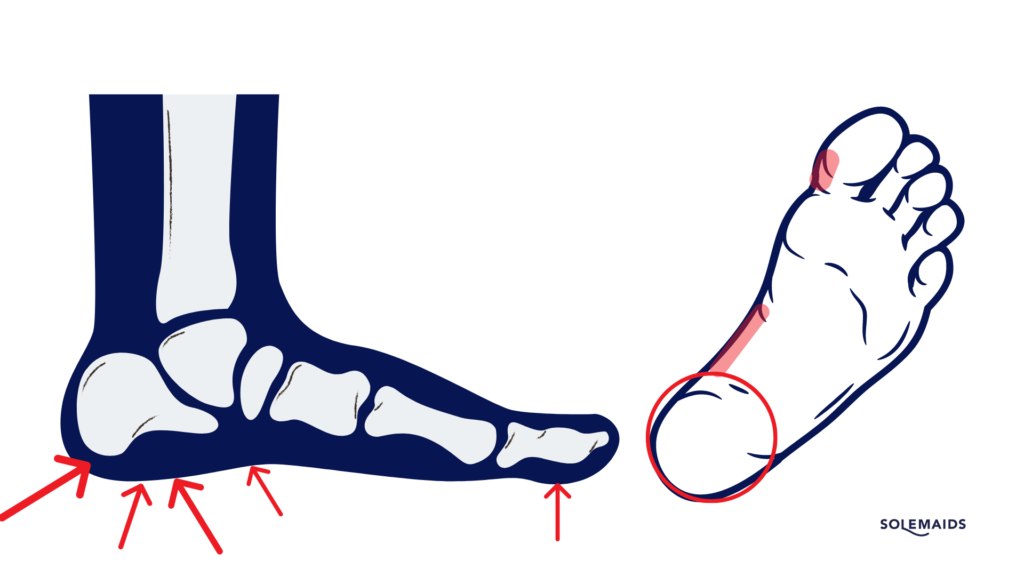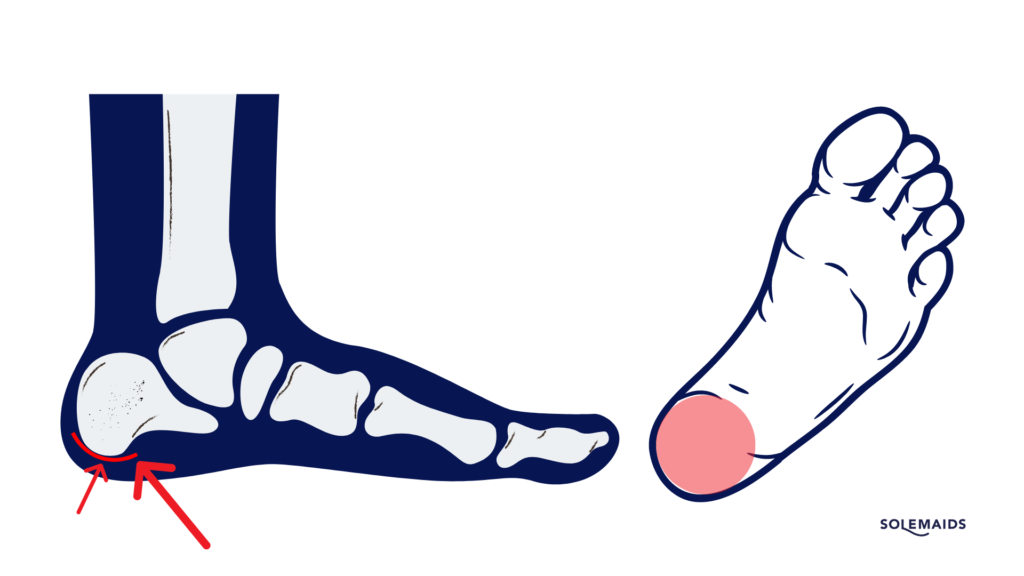Plantar heel pain in adults
Do you have plantar heel pain? It is very common and up to 10% of people above 50 years old will suffer from plantar heel pain (1). There can be many different reasons why you have plantar heel pain, but some of the most common causes are Plantar Fasciitis (sometimes referred to as heel spurs), Heel pad syndrome, Calcaneal fracture, Stress fracture, Calcaneal neuroma and Bone bruise.
Heel pain can be very disabling. Fortunately, there is help available if you suffer from heel pain. At Solemaids, we are specialists in heel pain, and our focus is on plantar heel pain, which is felt underneath the heel pad.
Do you experience some of the following symptoms? *
- Cannot step on heel pad without pain (typically in the morning)
- Swelling and redness at your heel pad
- Heel pain when standing
- Heel pain when walking
- Heel pain when resting
- Pain in the back of heel
- Pain when heel brushes against soft materials, such as pillows or blankets
- Diffuse pain around the heel
- A burning, stabbing and chasing pain
Then you are properly suffering from plantar heel pain – and we believe Solemaids PF can help you.
*Not all symptoms necessarily apply to you as they differ from diagnosis to diagnosis.
What is plantar heel pain?
Have you done the test in the video above? Do you have pain underneath your heel? Do you have heel pain without injury? Does your heel feel bruised? Then you might suffer from one of these causes of heel pain:
- Plantar Fasciitis
- Heel Pad Syndrome
- Calcaneal Stress Fracture
- Calcaneal Nerve Entrapment
- Bone Bruise

Plantar Fasciitis
Plantar fasciitis is an inflammation in the plantar ligament that connects the heel to the front of your foot. It is caused by loss of elasticity and strength: The symptoms are most often located at the inner side of the heel where the ligament is attached to the heel bone.
Plantar Fasciitis is often referred to as a heel spur, but they are not the same. A heel spur is an extra bone growth at the front of the heel bone. A heel spur is not necessarily painful.
Heel Pad Syndrome
Heel pad syndrome is a painful condition in the mid-heel. It is a result of the degeneration of cells, and it is caused by loss of elasticity and thinning of the heel pad under the heel bone.
The pain is often not only related to the heel pad but also the tissue surrounding the heel bone.


Calcaneal Stress Fracture
Calcaneal stress fracture is a smaller number of fractures in the bone cells of the heel. The symptoms are usually felt around or inside the heel bone and is caused by high-impact and repetitive activities like running.
Calcaneal Nerve Entrapment
Calcaneal nerve entrapment is tenderness in the nerve that runs on the middle or medial side of the heel. The symptoms are often constant and sometimes radiate to the toes.
Calcaneal nerve entrapment is often aggravated by repetitive stress like standing, walking, and running.


Bone Bruise
Bone bruise is a trauma to a bone. It’s less severe than a bone fracture. Boe bruise is an injury in the subchondral bone (the superficial bone tissue) typically caused by a high energy event against the bone, such as a fall or bouncing the heel against a hard object.
Bone bruises are common. They can happen to people of all ages. Symptoms are swelling of the heel bone and the soft tissue around it.
What causes plantar heel pain?
Causes for plantar heel pain are many and different causes are often concerned with different diagnoses. The risk of getting plantar heel pain increases with age. Heel pain can occur if you do a new and unfamiliar activity that puts a strain on the body. Perhaps you’ve walked in too tight or rigid shoes, stood on a ladder for a long time, walked in sand for a whole day, gone on a hiking holiday or bought some new shoes that’s not a good fit for your feet. Heel pain occurs from a lot of different reasons.
Just because you stop doing the new and unfamiliar activity, it’s not certain that your heel pain will disappear. You have kick-started a pain condition in the heel that persists. Sometimes heel pain appears suddenly and is not triggered by any new or unfamiliar activity.
Heel pain can be located at different areas on your heel. Besides plantar heel pain, which is underneath your heel, heel pain can occur at the front, side, and back of the heel. If you have heel pain at the back of the heel it’s often caused by the Achilles tendon. Heel pain can affect one or both heels – unilateral and bilateral heel pain. Usually heel pain occurs almost exclusively in one foot in adults. Try and feel where your heel pain is. Is it to the heel bone, the heel fat pad, the tissue surrounding the heel or somewhere else?
You might be concerned about whether other types of foot disorders increase the risk of heel pain. It can, for example, be flat feet. Flat-footed people do not have an increased risk of heel pain. For a professional evaluation, please contact one of our health professionals. See the list over certified clinics here.
Making the right diagnosis for heel pain
X-ray can be used to rule out fractures to the heel bone. Simple tests can also help diagnosing plantar heel pain. Visit a health professional for an assessment and diagnosis of your heel pain.
How to relieve plantar heel pain
- There are a lot of different heel pain treatments out there. Some more successful than others. Getting rid of heel pain as an adult can be a long and tedious process. Inactivity is not the answer as it can worsen your physical health. This is what we suggest you do:
- Walk and run less if you are in pain.
- Find an activity that does not stress the heels while the pain persists, such as cycling, swimming, rowing or cross-trainer.
- Contact a health professional to help you deal with your heel pain.
- Use a variety of footwear and only use footwear that is comfortable for you.
- Use Solemaids PF insoles to get pain relief while you stay active. Read more about Solemaids PF here.
- Strengthen your muscles in the foot by doing this simple heel pain exercise.
References
Thomas, Martin J., Rebecca Whittle, Hylton B. Menz, Trishna Rathod-Mistry, Michelle Marshall and Edward Roddy. 2019. Plantar heel pain in middle-aged and older adults: population prevalence, associations with health status and lifestyle factors, and frequency of healthcare use, BMC Musculoskeletal disorders. Vol. 20, no. 337.
